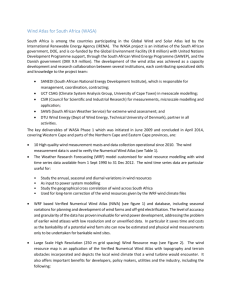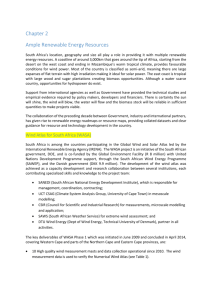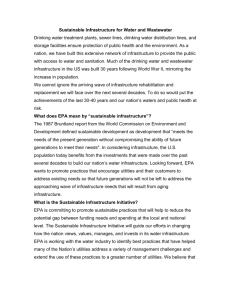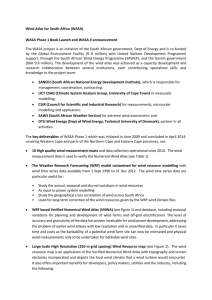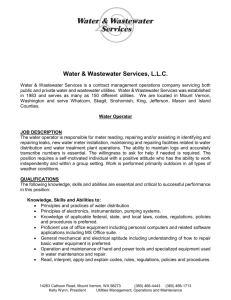GAO Testimony
advertisement
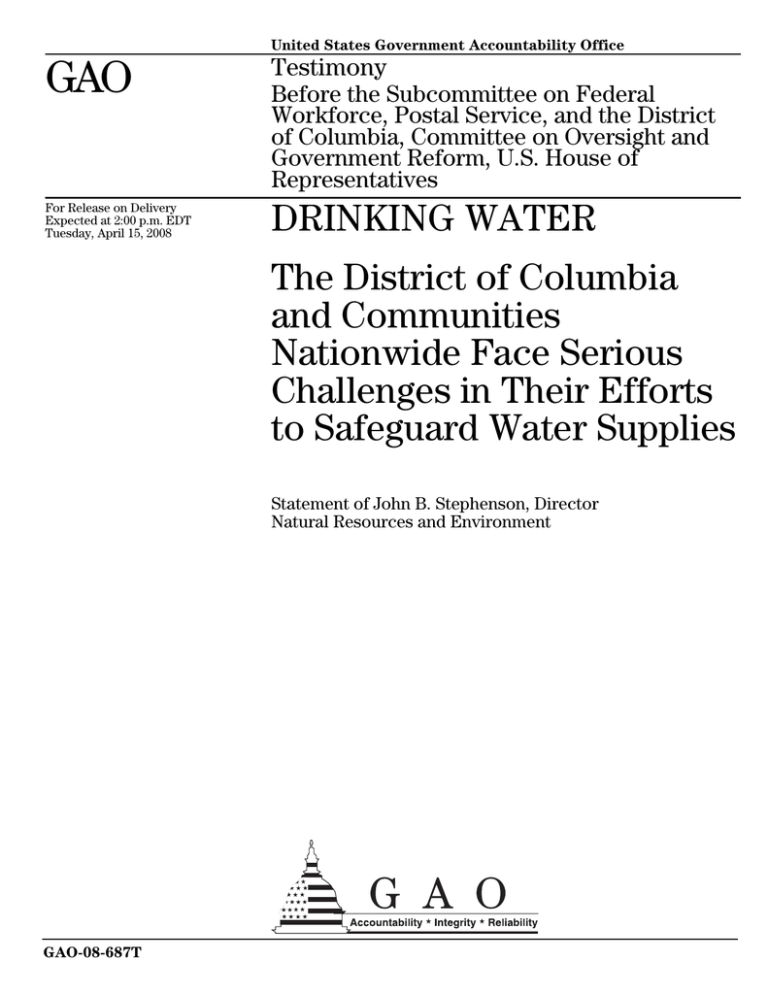
United States Government Accountability Office GAO Testimony Before the Subcommittee on Federal Workforce, Postal Service, and the District of Columbia, Committee on Oversight and Government Reform, U.S. House of Representatives For Release on Delivery Expected at 2:00 p.m. EDT Tuesday, April 15, 2008 DRINKING WATER The District of Columbia and Communities Nationwide Face Serious Challenges in Their Efforts to Safeguard Water Supplies Statement of John B. Stephenson, Director Natural Resources and Environment GAO-08-687T April 15, 2008 DRINKING WATER Accountability Integrity Reliability Highlights Highlights of GAO-08-687T, a testimony before the Subcommittee on Federal Workforce, Postal Service, and the District of Columbia, Committee on Oversight and Government Reform, U.S. House of Representatives The District of Columbia and Communities Nationwide Face Serious Challenges in Their Efforts to Safeguard Water Supplies Why GAO Did This Study What GAO Found The discovery in 2004 of lead contamination in the District of Columbia’s drinking water resulted in an administrative order between the Environmental Protection Agency (EPA) and the District’s Water and Sewer Authority (WASA), requiring WASA to take a number of corrective actions. WASA also took additional, longerterm measures, most notably a roughly $400 million program to replace what may be 35,000 lead service lines in public space within its service area. With the introduction of orthophosphate to its drinking water WASA has consistently tested below the federal action level for lead. However, WASA is reevaluating its roughly $400 million, longer-term solution for replacement of what may be 35,000 lead service lines within its jurisdiction. In addition to the program’s high cost, a key problem WASA faces is that, by law, it may only replace the portion of the service line that it owns; replacing the portion on private property is at the homeowner’s discretion. Accordingly, WASA has been encouraging homeowners to participate in the program by replacing their own portion of the lead lines. Despite these efforts, however, homeowner replacement of lead service lines remains limited. Of the 14,260 lead service lines WASA replaced through the first quarter of fiscal year 2008, there were only 2,128 instances in which the homeowner participated in private side replacement. Many questions remain about the benefits of partial lead service line replacement. In fact, some research to date suggests that partial service line replacement results in (1) short-term spikes in lead levels immediately after partial replacement and (2) little long-term reduction in lead levels. WASA’s dilemma over this program is taking place within the context of its other staggering infrastructure needs. Most notably, WASA is undertaking a $2.2 billion effort to meet the terms of a consent decree with EPA requiring the utility to control its sewer overflow problems. As in WASA’s case, water utilities nationwide are under increasing pressure to make significant investments to upgrade aging and deteriorating infrastructures, improve security, serve a growing population, and meet new regulatory requirements. In this context, GAO’s testimony presents observations on (1) WASA’s efforts to address lead contamination in light of its other pressing water infrastructure needs, and (2) the extent to which WASA’s challenges are indicative of those facing water utilities nationwide. To address these issues, GAO relied primarily on its 2005 and 2006 reports on lead contamination in drinking water, as well as other recent GAO reports examining the nation’s water infrastructure needs and strategies to address these needs. To view the full product, including the scope and methodology, click on GAO-08-687T. For more information, contact John B. Stephenson at (202) 512-3841 or stephensonj@gao.gov. WASA’s challenges in addressing its lead contamination problems and other infrastructure demands are mirrored across the country, where infrastructure needs are estimated to range from $485 billion to nearly $1.2 trillion nationwide over the next 20 years. In particular, many utilities have had difficulty in raising funds to repair, replace, or upgrade aging capital assets; comply with regulatory requirements; and expand capacity to meet increased demand. For example, based on a nationwide survey of several thousand drinking water and wastewater utilities, GAO reported in 2002 that 29 percent of the drinking water utilities and 41 percent of the wastewater utilities were not generating enough revenue from user rates and other local sources to cover their full cost of service. GAO also found that about one-third of the utilities (1) deferred maintenance because of insufficient funding, (2) had 20 percent or more of their pipelines nearing the end of their useful life, and (3) lacked basic plans for managing their capital assets. Other GAO work suggests that the nation’s water utilities could more effectively manage their infrastructure at a time when huge investments are needed. In 2004, for example, GAO cited “comprehensive asset management” as one approach that could help utilities better identify and manage their infrastructure needs. While by no means a panacea to their fundamental fiscal challenges, water utilities can use comprehensive asset management to minimize the total cost of designing, acquiring, operating, maintaining, replacing, and disposing of capital assets over their useful lives, while achieving desired service levels. United States Government Accountability Office Mr. Chairman and Members of the Subcommittee: We are pleased to be here to testify on the infrastructure challenges facing the District of Columbia’s Water and Sewer Authority (WASA), highlighting its efforts to reduce lead exposure. In doing so, we will also put our comments in the context of the many fiscal challenges and competing demands facing all water utilities, including WASA. Media reports in early 2004 about lead contamination of the District’s drinking water raised serious concerns about the health risks posed to its residents from existing lead service lines, and about how local and federal agencies were carrying out their responsibilities. WASA’s lack of timely disclosure of this problem, and the subsequent confused effort by government agencies to inform the public on steps to protect itself, led to numerous congressional hearings and a June 2004 administrative consent order between the Environmental Protection Agency (EPA) and WASA. WASA agreed to take a number of corrective actions, including improving its water sampling procedures and subsequent reporting of these results to EPA; enhancing its public education efforts; and developing a plan to identify additional lead service lines. In addition, orthophosphate was added to WASA’s water supply in August 2004 to form a protective coating inside lead service lines and fixtures to prevent lead from leaching into drinking water. To address the problem in the long-term, WASA decided to undertake what it estimates to be at least a $400 million program to replace the public portions of all its customers’ lead service lines (roughly 35,000 lines) by 2016 and to also provide various incentives to encourage the replacement of lead service lines in private space. In the District of Columbia, homeowners are responsible for the portion of the service line that runs from the property line to the home. Homeowners may replace this portion of the line if they choose, but this replacement is not required. The lead problem in the District of Columbia also prompted EPA to review the adequacy of federal regulations on lead in drinking water. In October 2007, EPA made several changes to the monitoring and public notice provisions of the Safe Drinking Water Act’s Lead and Copper Rule, the principal federal regulation protecting public water system consumers from exposure to lead and copper in drinking water. As important as the lead contamination problem has been to WASA and its customers, it is not the only issue with which the utility must grapple. Like many other large water utilities, WASA is also responsible for wastewater Page 1 GAO-08-687T collection and transmission, including operation and maintenance of its wastewater treatment facility and sanitary sewer system. While the utility has sought to modernize many parts of its wastewater facilities, some components date back to the early 19th century. Like most utilities, WASA must provide for replacement or rehabilitation of its existing system, and construct extensions to this system for development and growth as needed. The federal government has had a significant impact on the nation’s drinking water and wastewater infrastructure by (1) providing financial assistance to build new facilities or upgrade existing ones and (2) establishing regulatory requirements that affect the technology, operation, and maintenance of utility infrastructure. As the agency that regulates drinking water and surface water quality, EPA provides a significant amount of financial assistance for facilities that supply drinking water and treat wastewater. This assistance is primarily in the form of grants to the states to capitalize revolving loan funds, which are used to finance improvements to drinking water and wastewater treatment facilities. In addition to its financial investment, EPA has promulgated regulations to implement the Safe Drinking Water Act and Clean Water Act, which have been key factors in shaping water systems’ capital needs and management practices. In my testimony today I will present observations on (1) WASA’s efforts to address lead contamination in light of its other pressing water infrastructure needs, and (2) the extent to which WASA’s challenges are indicative of those facing other water utilities across the nation. To address these questions, we are summarizing and updating reports we issued in 20051 and in 20062 on the lead contamination problem in the District of Columbia’s drinking water supplies, and on the status of WASA’s effort to address this problem. We are also highlighting some of the work we have recently completed that addresses the magnitude of the nation’s water infrastructure needs, the problems utilities face in 1 GAO, District of Columbia’s Drinking Water: Agencies Have Improved Coordination, but Key Challenges Remain in Protecting the Public from Elevated Lead Levels, GAO-05-344 (Washington, D.C.: Mar. 31, 2005). 2 GAO, Drinking Water: EPA Should Strengthen Ongoing Efforts to Ensure That Consumers Are Protected from Lead Contamination, GAO-06-148 (Washington, D.C.: Jan. 4, 2006). Page 2 GAO-08-687T addressing them, and the strategies utilities can employ to help them best meet their needs. We prepared this testimony in April 2008, based on work performed over the last three years, in accordance with generally accepted government auditing standards. Those standards require that we plan and perform the audit to obtain sufficient, appropriate evidence to provide a reasonable basis for our findings and conclusions based on our audit objectives. We believe that the evidence obtained provides a reasonable basis for our findings and conclusions based on our audit objectives. In summary: • The introduction of orthophosphate to its water supply has enabled WASA to consistently test below the federal action level for lead in drinking water, but the Authority is reevaluating its longer-term roughly $400 million program to replace what may be 35,000 lead service lines in public space. Importantly, this program only addresses the replacement of the public portion of customers’ lead lines. Customers would need to finance replacement of their private portion of the lead lines (at a cost that could reach $2,500) on their own. Yet despite WASA’s efforts to encourage homeowner participation, private side replacement of lead service lines remains limited. Of the 14,260 lead service lines WASA replaced through the first quarter of fiscal year 2008, there were only 2,128 instances in which the homeowner participated in the private side replacement. Importantly, many questions remain about the benefits of partial lead service line replacement. Research suggests that short-term spikes in lead levels occur immediately after partial replacement, and little long-term reduction in lead levels may be achieved. WASA’s reevaluation of this program is taking place within the context of its staggering infrastructure needs, most notably a $2.2 billion effort to meet the terms of a consent decree with EPA to address sewer overflow problems. • WASA’s difficulties in meeting myriad fiscal demands are mirrored across the country: water infrastructure needs nationwide are estimated to range from $485 billion to nearly $1.2 trillion over the next 20 years. In particular, many utilities have had difficulty raising funds to repair, replace, or upgrade aging capital assets; comply with regulatory requirements; and expand capacity to meet increased demand. For example, based on a survey of several thousand drinking water and wastewater utilities, we reported in 2002 that 29 percent of the drinking water utilities, and 41 percent of the wastewater utilities, were not generating enough revenue from user rates and other local sources to Page 3 GAO-08-687T cover their full cost of service.3 We also found that about one-third of the utilities (1) deferred maintenance because of insufficient funding, (2) had 20 percent or more of their pipelines nearing the end of their useful life, and (3) lacked basic plans for managing their capital assets. Other GAO work suggests that the nation’s water utilities could more effectively manage their infrastructure at a time when huge investments are needed. In 2004, for example, we cited “comprehensive asset management” as one approach that can help utilities better identify and manage their infrastructure needs.4 Though by no means a panacea for their profound fiscal challenges, comprehensive asset management can help water utilities minimize the total cost of designing, acquiring, operating, maintaining, replacing, and disposing of capital assets over their life cycle, and can do so in a way that achieves the level of service customers desire. Background Lead contamination of drinking water is difficult and expensive to control. It seldom occurs naturally in source water supplies like rivers and lakes; therefore it cannot be treated at a centralized treatment facility. Rather, lead enters drinking water primarily from the corrosion of materials containing lead in the water distribution system and in household plumbing. These materials include lead service lines that connect a house to the water main, lead-based solder used in a house to join copper pipe, and brass faucets and other plumbing fixtures. The Safe Drinking Water Act is the key federal law protecting public water supplies from harmful contaminants.5 EPA’s 1991 Lead and Copper Rule, promulgated pursuant to the Act, requires water systems to protect consumers against exposure to elevated levels of lead in drinking water by chemically treating water to reduce its corrosiveness and by collecting water samples from consumer taps and testing them for evidence of lead corrosion.6 EPA considers lead to be elevated (known as the “action level”) when lead levels are higher than 15 parts per billion in over 10 percent of tap water samples taken. Because lead contamination generally 3 GAO, Water Infrastructure: Information on Financing, Capital Planning, and Privatization, GAO-02-764 (Washington, D.C.: Aug. 16, 2002). 4 GAO, Water Infrastructure: Comprehensive Asset Management Has Potential to Help Utilities Better Identify Needs and Plan Future Investments, GAO-04-461 (Washington, D.C.: Mar. 19, 2004). 5 42 U.S.C. 300f-300j. 6 40 C.F.R. pt. 141, subpart I. Page 4 GAO-08-687T occurs after water leaves the treatment plant, the Lead and Copper Rule requires testing for lead at consumers’ taps. If elevated lead levels are found and persist after treatment to minimize the water’s corrosiveness, the water system must annually replace 7 percent of the lead service lines that it owns. Implementation and enforcement of the Lead and Copper Rule in the District of Columbia is complicated because of the number and nature of the entities involved. The Washington Aqueduct, owned and operated by the U.S. Army Corps of Engineers, is responsible for water treatment (including corrosion control). WASA purchases water from the Washington Aqueduct and delivers it to District residents, and is responsible for monitoring tap water samples for lead. EPA Region III in Philadelphia has oversight and enforcement authority for the District’s public water systems. Similar to many of the other approximately 400 largest drinking water systems in the United States (i.e., serving populations greater than 100,000), WASA is also responsible for wastewater collection and transmission, including operation and maintenance of its wastewater treatment facility and sanitary sewer system. This water infrastructure in the District of Columbia, like in many older cities, is aging and will require substantial funding over the next several years for replacement or rehabilitation. WASA Has Reduced Lead in Drinking Water But Faces Many Other Challenges to its Water and Wastewater Infrastructure A June 17, 2004, administrative order for compliance on consent between EPA and WASA required WASA to take a number of corrective actions that, by necessity, enhanced its coordination with EPA and the D.C. Department of Health. Among these actions were developing a plan to identify additional lead service lines, improving the selection of sampling locations and reporting of water testing results to EPA, developing a strategy to improve WASA’s public education efforts, and collaborating with the D.C. Department of Health to set priorities for replacing lead service lines. Most importantly, with the introduction of orthophosphate to the drinking water supply, WASA met, and has continued to meet, federal standards for lead in drinking water.7 WASA’s most recent report on lead 7 Orthophosphate was introduced to the WASA’s drinking water supply in August 2004 to form a protective coating inside lead service lines and fixtures to prevent lead from leaching into drinking water. Page 5 GAO-08-687T levels in D.C. drinking water was delivered to EPA in January 2008. WASA reported that 90 percent of the samples had lead levels of 11 parts per billion (ppb) or less, which is below EPA’s lead action level of 15 ppb. This is the sixth monitoring period in a row that WASA has met the lead action level. To resolve its lead problem in the long-term, however, WASA decided that it needed to undertake a program to replace the public portions of all its customers’ lead service lines (roughly 35,000 lines) by 2016. WASA estimates that its program to replace all the District’s lead service lines will cost at least $400 million. Importantly, this figure reflects only the cost to replace the public portion of customers’ lead lines. Customers would need to finance replacement of their private portion of the lead lines (at a cost that could reach $2,500) on their own. Through the first quarter of fiscal year 2008, WASA has spent $105 million on the program, and expects to spend roughly another $300 million by 2016. Perhaps the most important complication facing WASA’s lead service line replacement program is that ownership of lead service lines in the District of Columbia is shared—WASA owns the portion from the water main to the property line, and homeowners own the portion from the property line to the home. Homeowners may pay to replace their portion of the lead service line at the same time as WASA replaces its portion, but are not required to do so. Figure 1 shows the configuration of a service line from the water main to a customer’s home. Page 6 GAO-08-687T Figure 1: Lead Service Line Configuration Property line Water main Service line Water meter Water shutoff valve Source: WASA. WASA established a program to encourage homeowners to replace their portion of lead service lines. This program included: • a low-interest loan program for low-income residents, offered through a local bank; • grants of up to $5,000 for low-income residents, offered by the District of Columbia Department of Housing and Community Development; and: • a fixed-fee structure for line replacement of $100 per linear foot plus $500 to connect through the wall of the home, to make pricing easier for homeowners to understand. Page 7 GAO-08-687T Despite these incentives, D.C. homeowners have been reluctant to replace the private side of the lead service line. Through the length of WASA’s lead service line replacement program, beginning in fiscal year 2003 and running through the first quarter of fiscal year 2008, of the 14,260 lead service lines replaced in public space, only 2,128 homeowners replaced the private portion of their lead service line.8 These totals are particularly troublesome given the lack of information about the benefits of partial lead service line replacement. Indeed, experts disagree about the effectiveness of removing only part of a lead service line. Studies that EPA cited in the Lead and Copper Rule suggest that longterm exposure to lead from drinking water decreases when a service line is only partially replaced. However, after partial replacement of a lead service line, exposure to lead in drinking water is likely to increase in the short term because cutting or moving the pipe can dislodge lead particles and disturb any protective coating on the inside of the pipe. Some experts believe that lead exposure can increase after partial service line replacement because of galvanic corrosion where the dissimilar metals of the old and new pipes meet. A study presented at the 2006 American Water Works Annual Conference summarizing the experience of partial lead service line replacement by the Greater Cincinnati Water Works found that partial replacements of lead lines resulted in much higher lead levels in the water for up to 1 month after replacement, even though the system was optimized for corrosion control.9 Even after this initial period, the sites with partial replacements had similar water lead concentrations as the sites in which the entire lead line was left in place—indicating there would be little, if any, benefit of partial lead line replacement. In the study, only completely replacing the lead service line resulted in both short- and long-term water quality improvements in all of the sites tested. The authors also noted that the use of a Teflon sleeve, or some other method of treating the portion of the line remaining in service, may help to protect water quality, but that more needs to be done in this area. Recognizing the need for more research, 8 WASA has indicated that of the service lines currently replaced in public space, 3,408 are also considered “full” replacements because it found that the private portion of the service line was already non-lead. 9 Jeff Swertfeger, David J. Hartman, Cliff Shrive, Deborah H. Metz, Jack DeMarco, et al. “Water Quality Effects of Partial Lead Line Replacement.” 2006 Annual American Water Works Association Conference, San Antonio, Texas. Page 8 GAO-08-687T EPA has partnered with the American Water Works Association Research Foundation on a study of the relative contributions of service lines and plumbing fixtures to lead levels at the tap. The projected completion of the study is November 2008. In light of these problems, WASA is now considering whether its current lead line replacement program should be restructured, particularly given its high cost and the competing demands on its budget. As a water utility serving a large metropolitan area, the lead problem has posed only one of several major infrastructure challenges for the utility and its customers. For example, approximately one-third of the District (by acreage) is served by combined sewers, which carry both sanitary waste from homes and businesses and storm water drainage. During storms this untreated sewage is discharged directly into the Anacostia and Potomac Rivers, adversely impacting the quality of these waters. To meet federal water quality standards, WASA will need to spend considerable sums of money to deal with the problem. Specifically, a March 2005 consent decree between WASA and EPA requires WASA, by 2025, to implement WASA’s long-term control plan, including construction of large underground tunnels to temporarily store excess flows until they can be treated at the Blue Plains Wastewater Treatment Plant and other measures, to significantly reduce combined sever overflows into the Anacostia River and other area waterways.10 WASA has estimated the cost of this effort to reach $2.2 billion dollars. WASA’s Water Infrastructure Problems Mirror the Challenges Water Utilities Face Nationwide WASA’s challenges are mirrored across the country, where projected needs for investment in drinking water and wastewater infrastructure range from $485 billion to nearly $1.2 trillion over 20 years. The variation in these estimates reflects alternative assumptions about the nature of existing capital stock, replacement rates, and financing costs. EPA reported in its most recent Drinking Water Infrastructure Needs Survey (issued in June 2005) that drinking water utilities alone will need an estimated $276.8 billion for the 20-year period ending in December 2022.11 EPA’s new estimate exceeds those from prior surveys by more than 60 percent, largely as a result of an increased emphasis on capturing 10 WASA states that combined sewer overflows will be reduced by 96 percent overall and by 98 percent in the Anacostia River. 11 U.S. Environmental Protection Agency, Drinking Water Infrastructure Needs Survey and Assessment, Third Report to Congress, EPA 816-R-05-001 (Washington, D.C.: June 2005). Page 9 GAO-08-687T previously underreported needs for infrastructure rehabilitation and replacement. According to EPA’s report, current needs increased by about 50 percent, but future needs rose by over 100 percent.12 EPA attributes the difference to a more complete assessment of the longer-term needs for addressing “aging infrastructure that is currently adequate, but will require replacement or significant rehabilitation over the next 20 years.” Pipeline rehabilitation and replacement represents a significant portion of the projected infrastructure needs for water utilities. EPA estimates that underground pipelines account for about 75 percent of the nation’s existing capital investment in drinking water and wastewater infrastructure. According to the American Society of Civil Engineers, U.S. drinking water and wastewater utilities are responsible for an estimated 800,000 miles of water delivery pipelines and between 600,000 and 800,000 miles of sewer pipelines, respectively. However, several recent studies have raised concerns about the condition of the existing pipeline network. For example, in August 2002, based on a nationwide survey of large drinking water and wastewater utilities, we reported that more than onethird of the utilities had 20 percent or more of their pipelines nearing the end of their useful life. In the case of one in 10 utilities, 50 percent or more of the utility’s pipelines were nearing the end of their useful life. Citing a “huge wave of aging pipe infrastructure,” the American Water Works Association in 2001 predicted a significant increase in pipe breaks and repair costs over the next 30 years—even if utilities increase their investment in pipe infrastructure several fold.13 Other studies make similar predictions for the pipelines owned by wastewater utilities.14 Despite the looming problems facing utility pipelines, our nationwide survey found that pipeline rehabilitation and replacement was not occurring as desired, with over two-thirds of the utilities reporting that 12 EPA defines current needs as projects that a system considers a high priority for nearterm implementation to enable a water system to continue to deliver safe drinking water. Future needs are defined as projects that water systems do not currently need but would expect to address in the next 20 years as part of routine maintenance or replacement of infrastructure because of predictable events, such as capital assets reaching the end of their useful life. 13 American Water Works Association Water Industry Technical Action Fund, Dawn of the Replacement Era: Reinvesting in Drinking Water Infrastructure (Denver, Colo.: May 2001). 14 For example, see Water Environment Research Foundation, New Pipes for Old: A Study of Recent Advances in Sewer Pipe Materials and Technology (2000). Page 10 GAO-08-687T they have fallen short of their desired pace of rehabilitation and replacement. Specifically, we found that roughly half of the utilities actually rehabilitated or replaced one percent or less of their pipelines annually, even though an estimated 89 percent of drinking water utilities and 76 percent of wastewater utilities believed that a higher level of rehabilitation and replacement should be occurring. More generally, we found that many utilities had deferred maintenance, minor capital improvements, and/or major capital improvements due to insufficient funding. About one-third of the utilities deferred maintenance expenditures, and similar percentages of utilities deferred expenditures in the other categories. According to EPA’s June 2005 Drinking Water Infrastructure Needs Survey, the largest category of need is the installation and maintenance of transmission and distribution systems—accounting for $183.6 billion, or about 66 percent of the needs projected through 2022. For wastewater systems, EPA’s 2004 Clean Watersheds Needs Survey projected infrastructure-related needs for publicly-owned wastewater systems of $202.5 billion through 2024.15 Several factors have contributed to the nation’s deteriorating water infrastructure over the years. The adequacy of the available funding, in particular, has been a key determinant of how well utility infrastructure has been maintained. However, according to our nationwide survey, a significant percentage of the utilities serving populations of 10,000 or more—29 percent of the drinking water utilities and 41 percent of the wastewater utilities—were not generating enough revenue from user charges and other local sources to cover their full cost of service. In addition, when asked about the frequency of rate increases during the period from 1992 to 2001, more than half the utilities reported raising their rates infrequently: once, twice, or not at all over the 10-year period. Our survey also raised questions about whether utility managers have enough information about their capital assets to effectively plan their future investment needs. We found that many utilities either did not have plans for managing their assets, or had plans that may not be adequate in scope or content. Specifically, more than one-fourth of the utilities did not have plans for managing their existing capital assets. Moreover, for the utilities that did have such plans, the plans in many instances did not cover all assets or did not contain one or more key elements, such as an 15 U.S. Environmental Protection Agency, Clean Watersheds Needs Survey 2004 Report to Congress, (Washington, D.C.: January 2008). Page 11 GAO-08-687T inventory of assets, assessment criteria, information on the assets’ condition, and the planned and actual expenditures to maintain the assets. Citing communities’ funding difficulties, many have looked to the federal government for financial assistance. However, if budgetary trends over the past few years serve as any indication, federal funding will not close the gap. The key federal programs supporting water infrastructure financing include the Clean Water State Revolving Fund (CWSRF) for wastewater facilities, and the Drinking Water State Revolving Fund (DWSRF) for drinking water facilities. Under each of these programs, the federal government provides seed money to states, which the states in turn use to support revolving funds that loan money to qualifying localities within their jurisdictions for new construction and upgrades. However, the trends and overall funding levels associated with these programs, suggest that they will only have a marginal impact in closing the long-term water infrastructure funding gap. Federal appropriations for the CWSRF in particular have decreased by nearly 50 percent during the past five years— from $1.34 billion enacted for fiscal year 2004 to $689 million enacted for fiscal year 2008. Funding for the DWSRF has remained virtually flat during the same period. Comprehensive Asset Management Can Be an Effective Tool for Managing Infrastructure and Optimizing Investments When Resources Are Constrained Growing infrastructure needs, combined with local pressure to keep user rates low, make it imperative that utilities manage their resources as cost effectively as possible. While hardly a “silver bullet” for the water industry’s massive shortfall in infrastructure funding, comprehensive asset management is one approach that has shown promise in helping utilities better identify their needs, set priorities, and plan future investments. Basic elements of comprehensive asset management include: collecting and organizing detailed information on assets; analyzing data to set priorities and make better decisions about assets; integrating data and decision making across the organization; and linking the strategy for addressing infrastructure needs to service goals, operating budgets, and capital improvement plans. At its most basic level, asset management gives utility managers the information they need to make sound decisions about maintaining, rehabilitating, and replacing capital assets—and to make a sound case for rate increases and proposed projects to their customers and governing bodies. Our 2004 report identified a number of asset management practices that could help water utilities better manage their infrastructure and target their investments to achieve the maximum benefit. Among other things, we found that collecting, analyzing, and sharing data across the Page 12 GAO-08-687T organization helped utilities make informed decisions about which assets to purchase, optimize their maintenance practices, and determine how long to repair an asset before replacement becomes more cost-effective. Some utility managers, for example, have used risk assessments to determine how critical certain assets (such as pipelines) are to their operations, considering both the likelihood and consequences of their failure. This systematic evaluation has helped them to target their resources accordingly, with the most critical assets receiving preventive maintenance while other, less critical assets received attention on an as needed basis. Having better information on utility assets has not only allowed managers to identify and prioritize investment needs, but has also helped them justify periodic rate increases to their customers and governing boards to pay for needed improvements. In one case, for example, utility managers modeled information on pipe performance history and replacement costs and predicted the approximate number of pipe breaks at various levels of funding. By understanding the trade-offs between lower rates and higher numbers of pipe breaks, the governing board was able to make an informed decision about the level of service that was appropriate for its community. Whether the problem is replacing lead service lines, as is the case for WASA, meeting new regulatory requirements, or paying the price for years of deferred maintenance, many utilities are facing huge investments to add new capital assets and replace others that are reaching the end of their useful life. Comprehensive asset management is one approach that shows real promise as a tool to help drinking water and wastewater utilities effectively target limited resources and, ultimately, ensure a sustainable water infrastructure for the future. Accordingly, our report recommended that the Environmental Protection Agency take steps to strengthen the agency’s existing initiatives on asset management and ensure that relevant information is accessible to those that need it. Mr. Chairman, this completes my prepared statement. I would be happy to respond to any questions you or other Members of this Subcommittee may have at this time. Page 13 GAO-08-687T Contact and Acknowledgements (360950) For further information, please contact John B. Stephenson at (202) 5123841. Individuals making key contributions to this testimony included Elizabeth Beardsley, Ellen Crocker, Steve Elstein, Tim Minelli, Nathan Morris, Alison O’Neill, and Lisa Turner. Page 14 GAO-08-687T This is a work of the U.S. government and is not subject to copyright protection in the United States. This published product may be reproduced and distributed in its entirety without further permission from GAO. However, because this work may contain copyrighted images or other material, permission from the copyright holder may be necessary if you wish to reproduce this material separately. GAO’s Mission The Government Accountability Office, the audit, evaluation, and investigative arm of Congress, exists to support Congress in meeting its constitutional responsibilities and to help improve the performance and accountability of the federal government for the American people. GAO examines the use of public funds; evaluates federal programs and policies; and provides analyses, recommendations, and other assistance to help Congress make informed oversight, policy, and funding decisions. GAO’s commitment to good government is reflected in its core values of accountability, integrity, and reliability. Obtaining Copies of GAO Reports and Testimony The fastest and easiest way to obtain copies of GAO documents at no cost is through GAO’s Web site (www.gao.gov). Each weekday, GAO posts newly released reports, testimony, and correspondence on its Web site. To have GAO e-mail you a list of newly posted products every afternoon, go to www.gao.gov and select “E-mail Updates.” Order by Mail or Phone The first copy of each printed report is free. Additional copies are $2 each. A check or money order should be made out to the Superintendent of Documents. GAO also accepts VISA and Mastercard. Orders for 100 or more copies mailed to a single address are discounted 25 percent. Orders should be sent to: U.S. Government Accountability Office 441 G Street NW, Room LM Washington, DC 20548 To order by Phone: Voice: TDD: Fax: (202) 512-6000 (202) 512-2537 (202) 512-6061 Contact: To Report Fraud, Waste, and Abuse in Federal Programs Web site: www.gao.gov/fraudnet/fraudnet.htm E-mail: fraudnet@gao.gov Automated answering system: (800) 424-5454 or (202) 512-7470 Congressional Relations Ralph Dawn, Managing Director, dawnr@gao.gov, (202) 512-4400 U.S. Government Accountability Office, 441 G Street NW, Room 7125 Washington, DC 20548 Public Affairs Chuck Young, Managing Director, youngc1@gao.gov, (202) 512-4800 U.S. Government Accountability Office, 441 G Street NW, Room 7149 Washington, DC 20548 PRINTED ON RECYCLED PAPER
